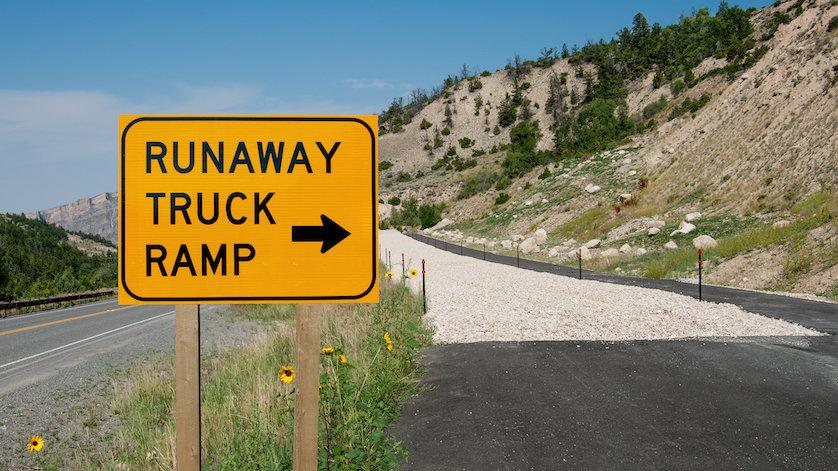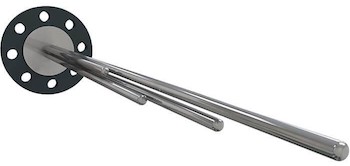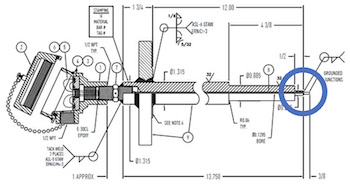
Thermal runaway reactions are one of the leading causes of accidents in chemical and petrochemical plants. To prevent such catastrophes, operators should continually monitor temperatures using sensors with the fastest possible response time for that application.
The manufacturing of ethylene oxide, acrylic acid, vinyl chloride, styrene, and other important products involves highly reactive and exothermic reactions. Because these chemical processes produce tremendous amounts of heat, they need to be managed carefully to prevent rapid temperature increases and runaway reactions.
The Dangers of Runaway Chemical Reactions
If you’ve ever driven on mountain roads, you likely have encountered runaway ramps. These dead-end ramps use an uphill grade and/or the friction of gravel to stop trucks that have lost the use of their brakes and are unable to control their vehicle as it barrels down a steep highway.
Runaway chemical reactions are similar. They are processes that have accelerated so much that they become very difficult or even impossible to control. In chemical plants, the equivalent of vehicle breaks are:
- Process control measures – lowering the temperature and pressure by reducing the feedstock’s flow rate and adjusting its concentration
- Heat removal techniques – such as cooling jackets, heat exchangers, and temperature control devices
The danger comes when these safety measures are insufficient or ineffective. If a runaway thermal reaction is not stopped, it can lead to explosions, fires, facility damage, toxic emissions, injuries, and loss of lives. And unfortunately for chemical plants, there is no equivalent of a runaway ramp if safety systems fail to stop out-of-control processes.
Controlling Chemical Reactions to Prevent Runaway Reactions
How well a petrochemical facility controls exothermic reactions is key to plant safety. Let’s take ethylene oxide (EO) as an example. C2H4O is widely used as a chemical intermediate in the manufacturing of a wide range of everyday products, from adhesives and solvents to detergents, textiles, and pharmaceuticals. Manufacturing EO involves exothermic reactions carried out in high temperatures and high pressures, producing a colorless gas that is very reactive and flammable.
EO reactors themselves are highly sensitive as well, and any disturbance can push these units into runaway conditions. Disturbances come in the form of process upsets, such as equipment malfunction/failure or a surge/drop in critical parameters, or even in preparation for a turnaround.
The Role of Temperature Sensors in Preventing Runaway Reactions
Managing a reaction’s temperature is the main way to influence its kinetics. As temperature and pressure are directly proportional when the volume is constant, to bring down a reaction’s temperature is to also reduce the pressure within an enclosed vessel. Temperature sensors, like thermocouples and resistance thermometers (RTDs), allow operators to continually monitor the temperature of exothermic chemical reactions.
Since temperature is such a critical parameter in exothermic reactions, which can reach runaway condition within a matter of seconds, a sensor’s response time also plays a crucial role in the control room’s ability to make informed decisions and effectively manage the process.
Chemical producers commonly use tubular reactors to convert hydrocarbon feedstock into ethylene oxide, acrylic acid, vinyl chloride, and styrene. Temperature sensors are customized to a reactor’s specific design, with varying dimensions, lengths, and number of measuring points.
Measuring instruments not only collect data, but they often act as safety mechanisms that trigger alarms when process conditions exceed predetermined parameters. With redundancies like a backup diaphragm element, sensors in critical applications prevent accidental media release in case of mechanical failures.
Sensor Configurations for Optimal Temperature Readings

TC96-M miniature multipoint thermocouple
There are different configurations of temperature measuring points available for tubular reactors. For the most accurate results, use miniature multipoint thermocouples, like the TC96-M, to quickly detect any sudden temperature changes in the length of the reactor. These sensors are connected to a temperature transmitter to quickly relay data to the control room.
Considerations and compromises in
temperature sensing
To ensure the reactor’s integrity and reliability, temperature sensors need to have a fast response time. The less material there is between the sensor tip and the medium, the faster the response time will be.

Thermocouple in an exposed-tip thermowell
An example of this is a grounded thermocouple inserted into an exposed-tip thermowell (see right) so that the sensor comes into direct contact with the gas or liquid. The tradeoff, of course, is that if the medium is aggressive or extremely hot, this configuration can significantly reduce the life of the temperature sensor.
In summary, these are some of the variables that affect thermal response times in temperature sensors:
- Type of temperature sensor. Generally, thermocouples have a faster response time than RTDs.
- Sensor size. The smaller the sensor, the faster its response time.
- Whether a thermowell is needed. This metal tube protects the sensor from high pressures, high temperatures, and abrasive/corrosive media.
- Thickness of the thermowell wall. The thinner the wall, the faster the response time, but the structural integrity of a thin-walled thermowell might suffer in high-velocity and turbulent conditions.
- Tip diameter of the thermowell. The less air there is between the sensor tip and the thermowell wall, the faster the response time will be.
- Type of medium. Liquid media will result in a faster response time than gaseous media due to a liquid’s greater contact with the measuring surface.
- The medium’s velocity and turbulence. Generally, faster-flowing and more turbulent media result in faster response times due to greater contact with the measuring surface.
WIKA USA, Expert Advice and Quality Sensors to Prevent Runaway Reactions
When choosing temperature instruments to monitor a reactor’s processes, the best practice is not to simply use the sensor with the shortest response time. Achieving the perfect equilibrium between response time and resilience in the process requires the advice of product specialists with experience in the chemical industry.
We can advise you on whether to use an RTD or thermocouple, and whether the temperature sensor can be inserted directly into the medium or should be used with a thermowell. If the latter, we can help you perform the wake frequency calculations to protect the tubes from mechanical stress. A helical stem, like our ScrutonWell® design, will minimize the wake formations that damage a thermowell’s stem and allow the medium to escape into the environment.
To keep your facility operating as safely and efficiently as possible, work with the experts at WIKA USA for temperature solutions that are optimized for your specific reactors and processes.
Product mentioned in this article
• TC96-M miniature multipoint thermocouple

